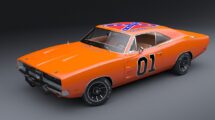
The concept of the "Death Touch"—a mystical martial arts technique said to incapacitate or even kill an opponent with a single strike—has captivated audiences for decades. Stories of legendary martial artists possessing this power have passed down through generations, often shrouded in myth and intrigue. While the death touch’s existence remains a subject of debate among martial artists and skeptics alike, the mythical allure surrounding it continues to thrive in popular culture.
Origins and Cultural Significance
The idea of a lethal, touch-based strike is prevalent in various martial traditions, most notably within the context of Asian martial arts. It is often associated with the Chinese art of Dim Mak (or "Death Touch"), which is thought to involve pressure point strikes aimed at vital areas of the body. Additionally, some speculate that the concept may have been inspired by other combat styles, such as Kyusho Jitsu—centering on the mastery of pressure points and how to exploit them for self-defense.
Culturally, the notion of the death touch resonates with themes of spiritual mastery and the profound connection between the mind and body. Many martial arts philosophies espouse the idea that true mastery transcends mere physical prowess and requires harmony between spiritual, mental, and physical forces. The death touch thus symbolizes an ultimate level of skill and understanding, where competition takes a backseat to the deeper, often esoteric aspects of martial training[^1].
The Legends: Masters and Myths
1. The Dim Mak Masters
The legends of Dim Mak practitioners have fueled fascination and fear alike. One of the most prominent figures in these narratives is the late Bruce Lee. Although he never claimed to possess the death touch, his incredible prowess and deep understanding of martial arts led to countless rumors and exaggerations surrounding his capabilities. In the world of martial arts, some legends suggest that he could incapacitate opponents with a flick of his wrist, exploiting their vulnerabilities without the need for extensive force.
Similarly, stories abound of practitioners like Wong Fei-hung and Takeda Sokaku, who were said to have demonstrated such abilities against opponents in demonstration matches or altercations. These stories are often embellished over time, leading to a blur between the mysterious aura of these masters and the extraordinary abilities ascribed to them[^2].
2. Cultural Icons in Film and Media
The fascination with the death touch has been further popularized by cinema and television. Movies such as "Enter the Dragon" and "Kill Bill" have depicted characters wielding seemingly supernatural powers to defeat entire hordes of enemies with a magical touch. These portrayals, while entertaining, often disregard the practicalities of martial arts training, instead blending in elements of fantasy and speculation.
The success of these films has only intensified interest in the death touch, with many aspiring martial artists seeking to learn its secrets, convinced that they could harness such an extraordinary ability themselves[^3].
The Reality Behind the Myth
While the death touch’s allure is undeniable, the scientific reality of human anatomy and physiology tells a different story. Strikes designed to generate lethal results typically require not just precise targets but also the kind of force that most casual practitioners could not realistically achieve. Pressure point strikes can cause temporary incapacitation or pain, but the idea of a single touch eliminating an opponent is largely mythological.
Additionally, modern combat sports emphasize controlled environments where practitioners spar against one another. These practitioners often rely on techniques honed through rigorous training, endurance, and strategy, rather than the mystical notions of a death touch. Consequently, the effectiveness of martial arts is a combination of skill, timing, and adaptability rather than an esoteric ability to end life with the casual flick of a finger.
In Conclusion
The death touch remains one of the most enigmatic and captivating concepts within martial arts lore. It thrives at the intersection of myth and reality, symbolizing humanity’s fascination with the extraordinary potential of the human body. While its existence in the literal sense is highly debatable, its role in storytelling and cultural narratives continues to inspire and intrigue.
As martial artists continue to explore their craft, the legends of the death touch will likely endure, serving as an enduring emblem of mastery, skill, and the mysteries yet to be unraveled within the martial arts world.
[^1]: For a comprehensive exploration of the philosophical underpinnings of martial arts, see A History of Martial Arts Philosophy by R.C. Latham. [^2]: The folklore surrounding figures such as Bruce Lee and Wong Fei-hung is well documented in Martial Arts Legends by John H. Miller. [^3]: To delve deeper into the portrayal of martial arts in cinema, refer to The Evolution of Martial Arts in Film by Laura J. Hensley.
The concept of the "Death Touch," a mystical martial arts technique said to incapacitate or even kill with a single strike, has garnered fascination for decades. This enchanting idea, steeped in myth and rich narratives of legendary martial artists, remains a subject of intrigue in both martial arts circles and popular culture.
Origins and Cultural Significance
The notion of a lethal, touch-based strike is deeply rooted in various martial traditions, especially within Asian martial arts. It is most commonly associated with the Chinese art of Dim Mak, translated as "Death Touch," which purportedly involves striking pressure points that target vital areas. Some suggest that this concept is also inspired by other martial arts, such as Kyusho Jitsu, which focuses on pressure points and their use in self-defense.
Beyond the technical details, the cultural resonance of the death touch touches on themes of spiritual mastery, intertwining the mind and body. Many martial arts philosophies emphasize that true mastery transcends physical abilities, requiring a harmonious connection among spiritual, mental, and physical elements. Thus, the death touch symbolizes the pinnacle of skill—one that transcends mere competition to embrace the deeper, esoteric dimensions of martial arts training.
The Legends: Masters and Myths
1. The Dim Mak Masters
Legendary figures in the world of Dim Mak practitioners have contributed significantly to the mystique surrounding the death touch. One of the most famous martial artists, Bruce Lee, never claimed to possess such a power, but his exceptional talent and understanding of martial arts led to rumors that he could incapacitate opponents effortlessly. Tales often emerge about masters like Wong Fei-hung and Takeda Sokaku, who were rumored to have shown these fatal abilities during demonstrations or confrontations. Over time, these stories become embellished, blurring the lines between the extraordinary prowess of these masters and the mythical powers attributed to them.
2. Cultural Icons in Film and Media
The allure of the death touch has been further amplified through cinema and television. Films such as "Enter the Dragon" and "Kill Bill" portray characters wielding seemingly supernatural abilities to defeat adversaries with mere touches. While such depictions entertain, they often overlook the realities of martial arts training by infusing elements of fantasy. Consequently, the success of these portrayals has stimulated interest in the death touch among aspiring martial artists, eager to uncover what they believe are the secrets to such extraordinary abilities.
The Reality Behind the Myth
The fascinating narrative of the death touch collides with the scientific understanding of human physiology and anatomy. Strikes intended to produce lethal outcomes necessitate precise targeting combined with a force that most casual practitioners cannot realistically achieve. While pressure point strikes can induce temporary incapacitation or pain, the notion of a single touch leading to someone’s demise is largely mythical.
Moreover, modern combat sports emphasize a controlled environment where practitioners strive against one another, relying on techniques developed through rigorous training and strategy, not mystical abilities. Thus, the effectiveness of martial arts arises from skill, timing, and adaptability, rather than an esoteric capacity to end life with a simple flick of a finger.
In Conclusion
The death touch remains one of the most captivating, enigmatic concepts in martial arts lore, thriving at the intersection of myth and reality. Symbolizing the extraordinary potential of the human body, its literal existence is hotly debated, yet it continues to play a vital role in storytelling and cultural narratives—a source of inspiration and intrigue.
As martial artists explore their craft, the legends of the death touch will likely endure, embodying mastery, skill, and the mysteries that persist within the martial arts community.
References:
- R.C. Latham, A History of Martial Arts Philosophy.
- John H. Miller, Martial Arts Legends.
- Laura J. Hensley, The Evolution of Martial Arts in Film.
































Add Comment